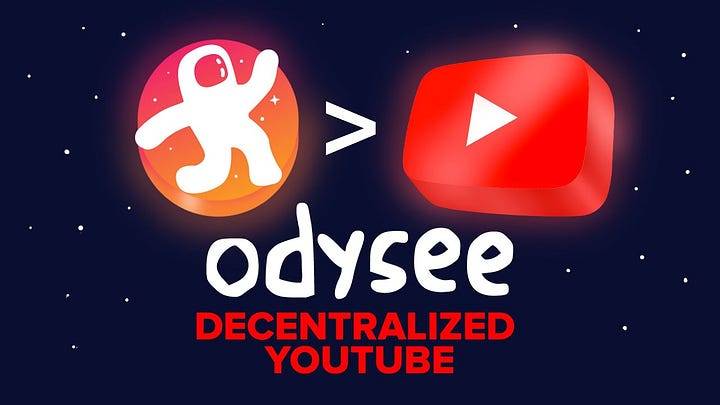### The Odysee Decentralized Network: Pioneering Content Sharing in Web3
In the rapidly evolving landscape of Web3, decentralized platforms like Odysee are gaining traction as alternatives to mainstream, centralized services like YouTube. Built on the LBRY (Library) blockchain protocol, Odysee offers a decentralized, censorship-resistant video-sharing experience that leverages blockchain technology to create a new way for creators and consumers to interact, share, and monetize content. Below is an exploration of how Odysee's decentralized infrastructure works, its advantages, and the potential challenges it faces as a part of the Web3 ecosystem.
---
### 1. Understanding Odysee and the LBRY Protocol
Odysee is a video-sharing platform built on top of the LBRY blockchain protocol, a decentralized network for data sharing and digital content distribution. The LBRY protocol is a distributed, peer-to-peer network that allows content creators to publish and monetize their work without relying on centralized services. It also ensures users have ownership and control over the content they create and consume. In the LBRY protocol, users act as both content hosts and consumers, creating a network where videos and other digital content are shared directly among users rather than through a single, centralized server.
This network is enabled by the LBRY blockchain, which records all transactions and interactions on the platform, from publishing content to tracking views and payments. As a result, the LBRY protocol establishes a trustless environment where users can validate content ownership, access, and distribution transparently.
### 2. How Odysee's Decentralization Works
Decentralization in Odysee is achieved through two main features of the LBRY protocol:
#### a) Content Hosting and Sharing
Odysee uses a peer-to-peer (P2P) architecture, where content is distributed across a network of user-run nodes. Each user can host content locally and share it with others, similar to the architecture of torrent networks. When a viewer requests a video on Odysee, the request is directed to nodes holding a copy of that content, ensuring data availability without requiring centralized servers.
#### b) Blockchain-Based Content Identification
Each piece of content published on the LBRY network is registered as a unique entry on the blockchain, which acts as an immutable record of metadata like the creator’s ID, content description, and location within the network. This metadata ensures that content is easily searchable and accessible while allowing creators to verify and retain ownership of their work.
### 3. Content Monetization on Odysee
Odysee allows creators to monetize content through two main revenue models:
#### a) LBRY Credits (LBC)
LBRY Credits (LBC) is the native cryptocurrency of the LBRY protocol, used for payments and rewards on the Odysee platform. Creators can set a price for content access, or they can allow free viewing with an option for viewers to tip using LBC. Additionally, viewers are rewarded with LBC for engaging in the network, such as watching videos, subscribing to channels, or sharing content, which promotes active participation.
#### b) Channel Subscriptions and Premium Content
Odysee enables content creators to create premium channels, where exclusive content is only accessible to paying subscribers. This subscription model empowers creators to generate a steady revenue stream while maintaining direct relationships with their audience. Unlike conventional platforms, which take a large cut of revenue, Odysee allows creators to retain nearly all earnings, aligning with the decentralization ethos.
### 4. Key Advantages of Odysee's Decentralized Architecture
#### a) Content Ownership and Freedom from Censorship
Decentralized platforms like Odysee offer an alternative to centralized content platforms, where content can be censored or removed based on corporate policies or government mandates. With content spread across the P2P network and transactions recorded on the blockchain, creators retain complete control over their work, while censorship becomes far more challenging.
#### b) Greater Transparency
Odysee’s decentralized and blockchain-based approach enhances transparency. All transactions, interactions, and revenue flows are recorded on the blockchain, which can be audited by anyone. This transparency ensures that creators have full visibility into how their content is performing and how revenue is generated.
#### c) Resilient Content Distribution
With its P2P network, Odysee mitigates the risk of a single point of failure. Unlike centralized servers, where a server outage or attack can make content temporarily unavailable, Odysee’s decentralized network ensures that content remains accessible as long as there are nodes available with the requested data. This resilience is particularly important in regions where internet access is restricted or regulated.
### 5. Challenges and Limitations
#### a) Content Discovery and Searchability
The decentralized nature of Odysee’s network can complicate content discovery and indexing. While metadata is stored on the blockchain, there are limitations to the speed and efficiency with which content can be searched compared to traditional, centralized platforms like YouTube, which use sophisticated algorithms to personalize and rank content for users.
#### b) Scalability and Performance
As more users join and add content to the network, maintaining scalability without compromising performance is challenging. The P2P infrastructure requires significant bandwidth and storage, which can lead to slower content delivery, especially for high-definition videos. Enhancements in protocols and infrastructure may be necessary for Odysee to scale to mainstream levels.
#### c) Regulatory Challenges
Decentralized networks face regulatory scrutiny, particularly around content ownership, copyright enforcement, and illegal material. Odysee, like other blockchain-based platforms, must comply with regulations on a global scale, which can be challenging due to the decentralized and borderless nature of blockchain.
### 6. The Future of Odysee in the Web3 Landscape
As Web3 adoption grows, decentralized platforms like Odysee are well-positioned to lead the way in user-owned, censorship-resistant content-sharing ecosystems. However, to achieve mainstream success, Odysee must continue evolving its infrastructure to meet the demands of scalability, content discovery, and user experience while navigating regulatory environments. As more users seek platforms that prioritize privacy, transparency, and creator ownership, Odysee’s decentralized approach provides a compelling alternative to traditional video-sharing platforms.
In the context of Web3’s core values of decentralization, transparency, and trustlessness, Odysee offers a pioneering model for the future of digital content sharing. If Odysee and other decentralized networks can address current challenges, they have the potential to redefine how we interact with digital content and democratize online content distribution for the next generation.


